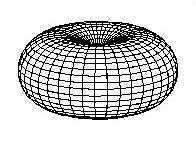 | ||
In radio communication, an omnidirectional antenna is a class of antenna which radiates radio wave power uniformly in all directions in one plane, with the radiated power decreasing with elevation angle above or below the plane, dropping to zero on the antenna's axis. This radiation pattern is often described as "doughnut shaped". Note that this is different from an isotropic antenna, which radiates equal power in all directions and has a "spherical" radiation pattern. Omnidirectional antennas oriented vertically are widely used for nondirectional antennas on the surface of the Earth because they radiate equally in all horizontal directions, while the power radiated drops off with elevation angle so little radio energy is aimed into the sky or down toward the earth and wasted. Omnidirectional antennas are widely used for radio broadcasting antennas, and in mobile devices that use radio such as cell phones, FM radios, walkie-talkies, wireless computer networks, cordless phones, GPS as well as for base stations that communicate with mobile radios, such as police and taxi dispatchers and aircraft communications.
Contents
Types
Common types of low-gain omnidirectional antennas are the whip antenna, "Rubber Ducky" antenna, ground plane antenna, vertically oriented dipole antenna, discone antenna, mast radiator, horizontal loop antenna (sometimes known colloquially as a 'circular aerial' because of the shape) and the halo antenna.
Higher-gain omnidirectional antennas can also be built. "Higher gain" in this case means that the antenna radiates less energy at higher and lower elevation angles and more in the horizontal directions. High-gain omnidirectional antennas are generally realized using collinear dipole arrays. These consist of multiple half-wave dipoles mounted collinearly (in a line), fed in phase. The coaxial collinear (COCO) antenna uses transposed coaxial sections to produce in-phase half-wavelength radiators. A Franklin Array uses short U-shaped half-wavelength sections whose radiation cancels in the far-field to bring each half-wavelength dipole section into equal phase. Another type is the Omnidirectional Microstrip Antenna (OMA).
Analysis
Omnidirectional radiation patterns are produced by the simplest practical antennas, monopole and dipole antennas, consisting of one or two straight rod conductors on a common axis. Antenna gain (G) is defined as antenna efficiency (e) multiplied by antenna directivity (D) which is expressed mathematically as:
